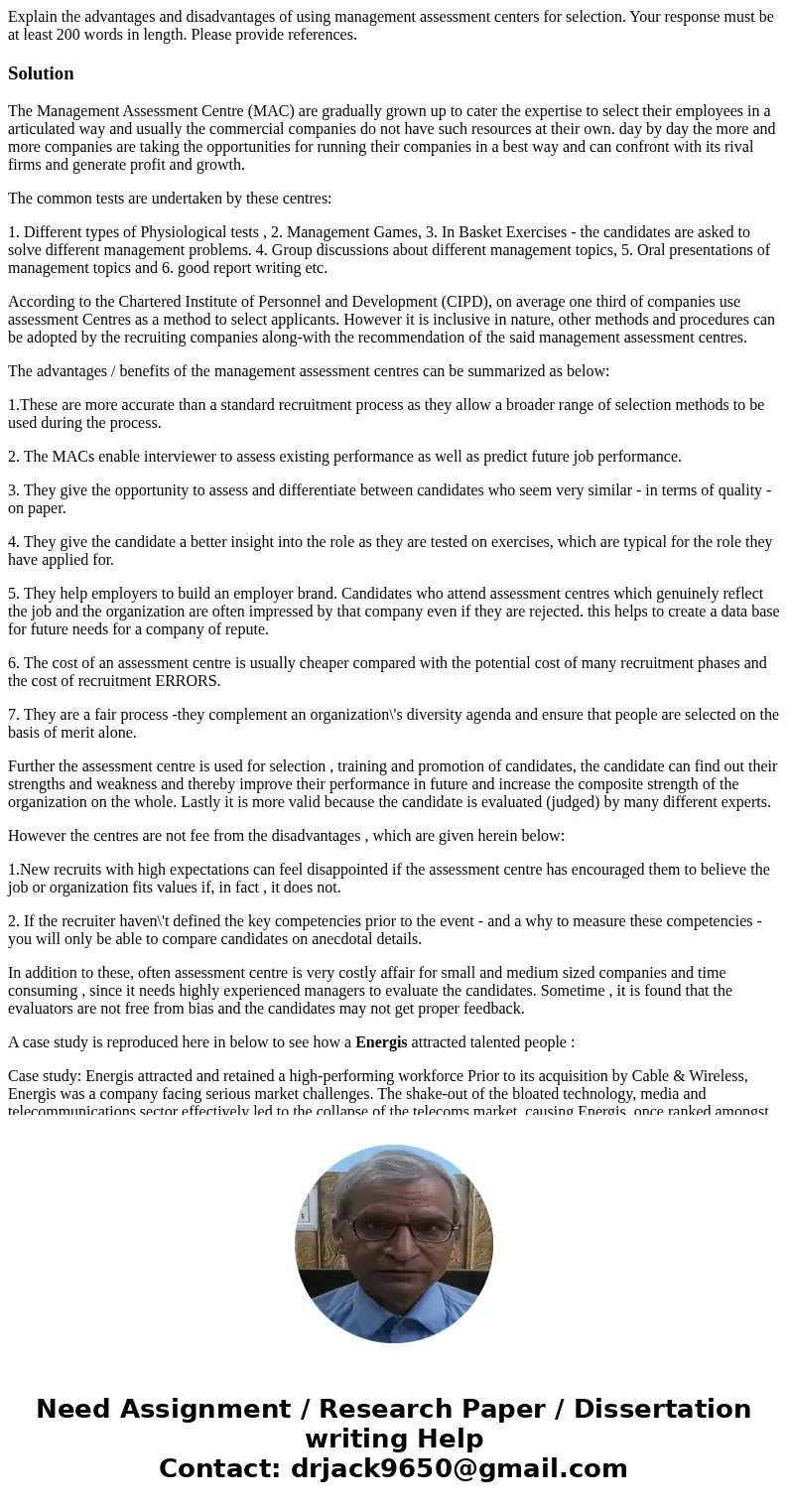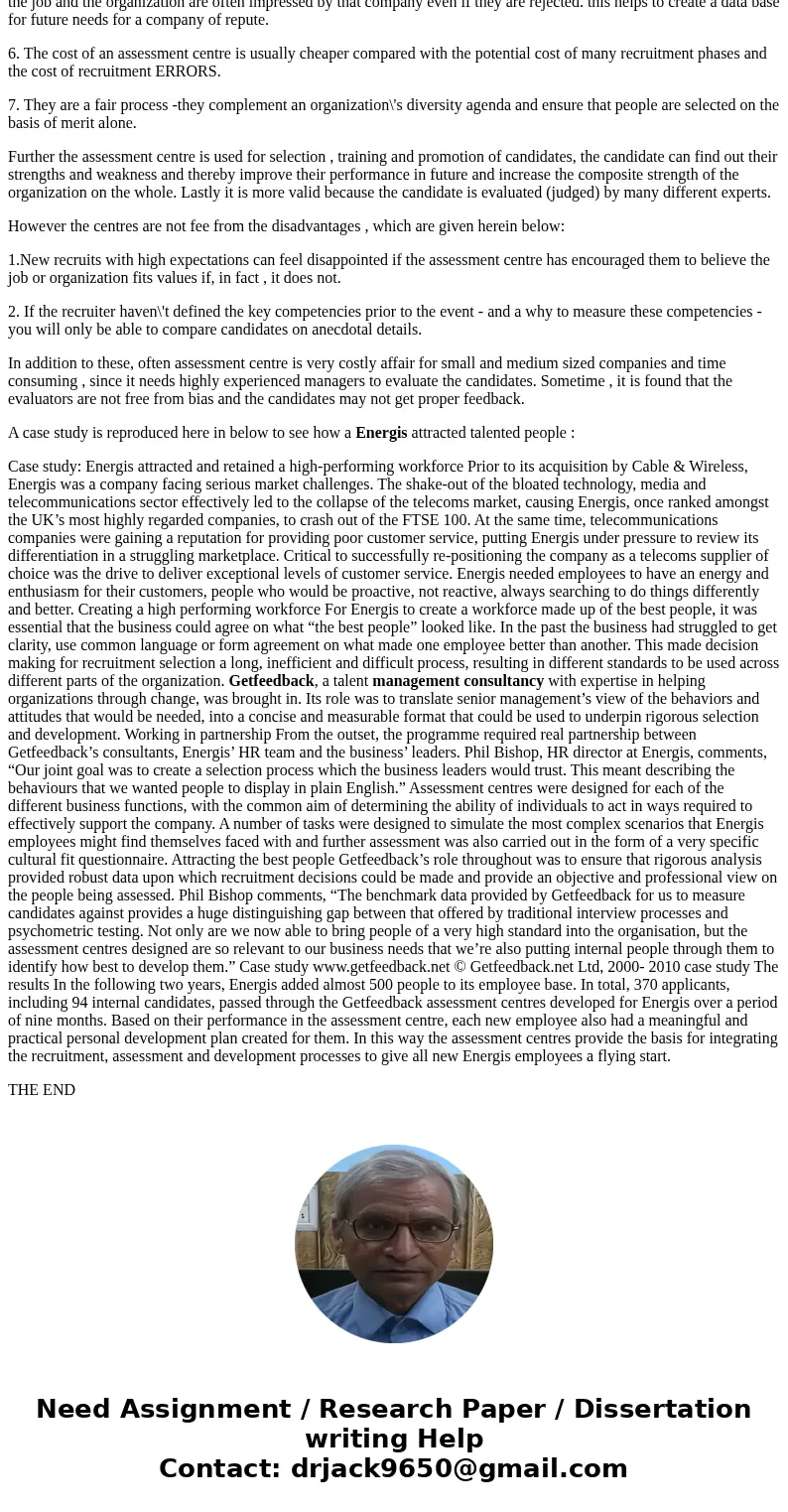Explain the advantages and disadvantages of using management
Explain the advantages and disadvantages of using management assessment centers for selection. Your response must be at least 200 words in length. Please provide references.
Solution
The Management Assessment Centre (MAC) are gradually grown up to cater the expertise to select their employees in a articulated way and usually the commercial companies do not have such resources at their own. day by day the more and more companies are taking the opportunities for running their companies in a best way and can confront with its rival firms and generate profit and growth.
The common tests are undertaken by these centres:
1. Different types of Physiological tests , 2. Management Games, 3. In Basket Exercises - the candidates are asked to solve different management problems. 4. Group discussions about different management topics, 5. Oral presentations of management topics and 6. good report writing etc.
According to the Chartered Institute of Personnel and Development (CIPD), on average one third of companies use assessment Centres as a method to select applicants. However it is inclusive in nature, other methods and procedures can be adopted by the recruiting companies along-with the recommendation of the said management assessment centres.
The advantages / benefits of the management assessment centres can be summarized as below:
1.These are more accurate than a standard recruitment process as they allow a broader range of selection methods to be used during the process.
2. The MACs enable interviewer to assess existing performance as well as predict future job performance.
3. They give the opportunity to assess and differentiate between candidates who seem very similar - in terms of quality -on paper.
4. They give the candidate a better insight into the role as they are tested on exercises, which are typical for the role they have applied for.
5. They help employers to build an employer brand. Candidates who attend assessment centres which genuinely reflect the job and the organization are often impressed by that company even if they are rejected. this helps to create a data base for future needs for a company of repute.
6. The cost of an assessment centre is usually cheaper compared with the potential cost of many recruitment phases and the cost of recruitment ERRORS.
7. They are a fair process -they complement an organization\'s diversity agenda and ensure that people are selected on the basis of merit alone.
Further the assessment centre is used for selection , training and promotion of candidates, the candidate can find out their strengths and weakness and thereby improve their performance in future and increase the composite strength of the organization on the whole. Lastly it is more valid because the candidate is evaluated (judged) by many different experts.
However the centres are not fee from the disadvantages , which are given herein below:
1.New recruits with high expectations can feel disappointed if the assessment centre has encouraged them to believe the job or organization fits values if, in fact , it does not.
2. If the recruiter haven\'t defined the key competencies prior to the event - and a why to measure these competencies -you will only be able to compare candidates on anecdotal details.
In addition to these, often assessment centre is very costly affair for small and medium sized companies and time consuming , since it needs highly experienced managers to evaluate the candidates. Sometime , it is found that the evaluators are not free from bias and the candidates may not get proper feedback.
A case study is reproduced here in below to see how a Energis attracted talented people :
Case study: Energis attracted and retained a high-performing workforce Prior to its acquisition by Cable & Wireless, Energis was a company facing serious market challenges. The shake-out of the bloated technology, media and telecommunications sector effectively led to the collapse of the telecoms market, causing Energis, once ranked amongst the UK’s most highly regarded companies, to crash out of the FTSE 100. At the same time, telecommunications companies were gaining a reputation for providing poor customer service, putting Energis under pressure to review its differentiation in a struggling marketplace. Critical to successfully re-positioning the company as a telecoms supplier of choice was the drive to deliver exceptional levels of customer service. Energis needed employees to have an energy and enthusiasm for their customers, people who would be proactive, not reactive, always searching to do things differently and better. Creating a high performing workforce For Energis to create a workforce made up of the best people, it was essential that the business could agree on what “the best people” looked like. In the past the business had struggled to get clarity, use common language or form agreement on what made one employee better than another. This made decision making for recruitment selection a long, inefficient and difficult process, resulting in different standards to be used across different parts of the organization. Getfeedback, a talent management consultancy with expertise in helping organizations through change, was brought in. Its role was to translate senior management’s view of the behaviors and attitudes that would be needed, into a concise and measurable format that could be used to underpin rigorous selection and development. Working in partnership From the outset, the programme required real partnership between Getfeedback’s consultants, Energis’ HR team and the business’ leaders. Phil Bishop, HR director at Energis, comments, “Our joint goal was to create a selection process which the business leaders would trust. This meant describing the behaviours that we wanted people to display in plain English.” Assessment centres were designed for each of the different business functions, with the common aim of determining the ability of individuals to act in ways required to effectively support the company. A number of tasks were designed to simulate the most complex scenarios that Energis employees might find themselves faced with and further assessment was also carried out in the form of a very specific cultural fit questionnaire. Attracting the best people Getfeedback’s role throughout was to ensure that rigorous analysis provided robust data upon which recruitment decisions could be made and provide an objective and professional view on the people being assessed. Phil Bishop comments, “The benchmark data provided by Getfeedback for us to measure candidates against provides a huge distinguishing gap between that offered by traditional interview processes and psychometric testing. Not only are we now able to bring people of a very high standard into the organisation, but the assessment centres designed are so relevant to our business needs that we’re also putting internal people through them to identify how best to develop them.” Case study www.getfeedback.net © Getfeedback.net Ltd, 2000- 2010 case study The results In the following two years, Energis added almost 500 people to its employee base. In total, 370 applicants, including 94 internal candidates, passed through the Getfeedback assessment centres developed for Energis over a period of nine months. Based on their performance in the assessment centre, each new employee also had a meaningful and practical personal development plan created for them. In this way the assessment centres provide the basis for integrating the recruitment, assessment and development processes to give all new Energis employees a flying start.
THE END


 Homework Sourse
Homework Sourse